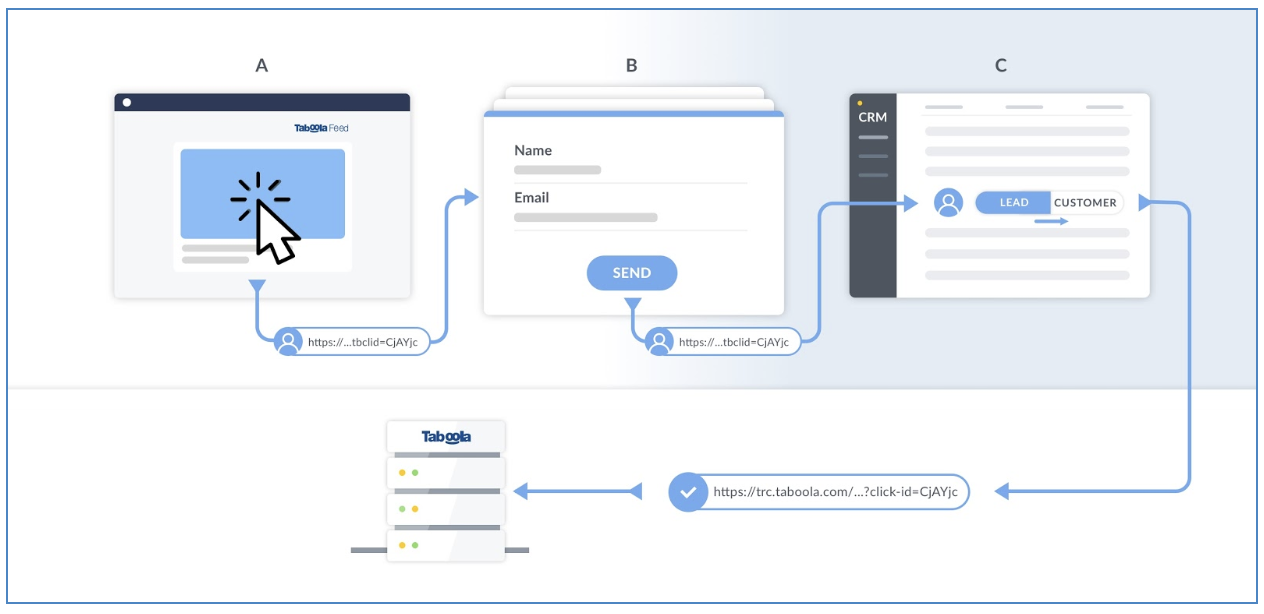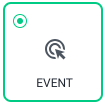Track CRM-based conversions using S2S
Overview
This topic describes how to track CRM-based conversions using server-to-server (S2S) integration.
CRM-based conversions occur offline - outside the browser - and cannot be tracked using the Taboola Pixel. Examples include phone orders, in-person appointments, and bookings that occur after initial lead capture.
With S2S integration, your CRM sends conversion data directly to Taboola, allowing you to attribute offline conversions to your ads.
Intended audienceThis flow requires some technical knowledge, as well as access to your CRM system.
Custom development is required to pass events from your CRM to Taboola.
How it works

- User clicks your ad (A) - The Click ID is automatically appended to the landing page URL as
tblci={click_id}. - User submits a form (B) - Your website captures the Click ID and sends it with the lead data to your CRM.
- Lead progresses in CRM (C) - Your CRM stores the Click ID with the lead record.
- Conversion occurs - When the lead converts (e.g., completes a purchase), your CRM sends an HTTP request to Taboola with the stored Click ID, attributing the conversion to the original ad.
The Click IDWhen your ad displays, the Click ID macro generates an actual Click ID value.
This is a case-sensitive string of variable length (approximately 120 characters). It looks something like this:
tblzFZwgwCiBdupCXVpES7FFRezBmaMqFWoprNPZbbq4Z_zMDu-XC_BC5YBiewdbqytuYAiC5YCi5YDC5YDiewdbqytuYAkAAMqFWoprNPZbbq4Z
Default Click ID param (tblci)Taboola automatically appends the following to all ad URLs:
tblci={click_id}If your CRM can accept this param, you are good to go. Otherwise, you will need to add a custom param (see below).
Setup overview
The setup process involves 4 steps:
- Create an event-based conversion rule in Realize.
- (Optional) Customize the Click ID parameter name (only if
tblcidoesn't work for your system). - Configure your CRM to send conversion events to Taboola.
- Capture and store the Click ID on your website.
Realize setup
Create an event-based conversion rule
Create an event-based conversion to capture your CRM event:
-
Open Realize, and select the account (top, right) that you will use to track conversions.
-
In the sidebar (left), select
Tracking. -
Click on
+ New Conversion(far right).Select
Create conversions using codeand clickContinue. -
Type in a
Conversion Nameof your choice - e.g.Appointment Scheduled.This is a descriptive name for your convenience. It does not need to match the Event Name.
-
For
Conversion Type, selectEVENT:
-
(Optional) If relevant, fill in a
Fixed Value.For additional guidelines, see the Help Center.
-
Scroll through the list of categories provided and select the relevant
Category- e.g.Lead. -
In the
Event Namefield, enter a name that fits your system's naming convention - e.g.appointment_scheduled.The Event Name you enter here must match exactly the event name you pass in the HTTP request from your CRM. If the naming convention is not identical, Taboola will not receive the event.
-
(Optional) If desired, edit the following fields:
Click Through Conversion WindowView Through Conversion Window
-
(Optional) If relevant, clear the
Include in total conversionscheckbox.Tip: Always include the most important conversions, so that the Taboola algorithm will optimize towards them. For additional guidelines, see the Help Center.
-
(Optional) If relevant, clear the
Include in total valuecheckbox. -
(Optional) If desired, edit the following fields:
Audience PropertiesAggregation Type
-
Skip the
Event Codesection.You will post the event values to Taboola via your CRM's HTTP request.
-
Review your chosen settings, and click on
Create(bottom, right):
Add a custom Click ID param (optional)
By default, Taboola automatically appends
tblci={click_id}to all ad URLs. Only follow these steps if you need to use a different parameter name.
Add a custom Click ID parameter to your campaign:
-
Open Realize, and select the account (top, right) that is running the campaign.
-
Locate the relevant campaign and click on the
Edit Campaignicon:
-
Within the campaign settings, scroll down to the
</> Trackingsection. -
Append your custom parameter to the existing query string:
&click_id={click_id}ExampleOriginal string:
utm_source=taboola&utm_medium=referralUpdated string:
utm_source=taboola&utm_medium=referral&click_id={click_id} -
Click on
Save(bottom, right):

CRM setup
Create a Click ID field
At the lead level in your CRM, create a new field to store the Click ID:
- Field name:
tblci(or your custom parameter name if you configured one in the previous section) - Field type: Alphanumeric (up to 1,000 characters)
- Purpose: Associates the lead with their ad interaction
The field name must match the parameter name from your ad URLs. Use
tblci(the default), or your custom parameter name if you configured one.
Create a conversion trigger
Configure your CRM to send an HTTP request to Taboola when a conversion occurs. For example, when a sales person schedules an appointment with a lead.
Endpoint:
https://trc.taboola.com/actions-handler/log/3/s2s-action?click-id=CLICK_ID&name=EVENT_NAMEExample:
https://trc.taboola.com/actions-handler/log/3/s2s-action?click-id=CjA2Yjc5NDM2Yy1lZDE3LTQzZTgtYTNlMi1lMTE4M2MzYTI5ZGQtdHVjdDJiYmE4ZmYSEHNpbmGpdmliZXNuZXctc2M&name=appointment_scheduled
Multiple eventsYou can track multiple conversion events. Create a distinct event-based conversion rule in Realize for each event you want to measure.
Bulk submissionFor high-volume scenarios, use the bulk submission API endpoint instead of individual postback requests.
For details, see Bulk submit conversions.
Capture the Click ID on your website
Your website must capture the Click ID from the URL and pass it to your CRM:
- Extract the Click ID parameter value (
tblciby default, or your custom parameter name) from the URL. - Store the value in a cookie, local storage, or similar storage method.
- When a user completes an action (e.g., submits a lead form), extract the Click ID from storage and send it to your CRM along with the lead details.
This can be done using a hidden form field or any suitable method for your system.
- Your CRM stores the Click ID in the field you created earlier.
Verification
Once your setup is complete, verify that conversion events are being tracked correctly.
Related topics
Updated about 1 month ago
